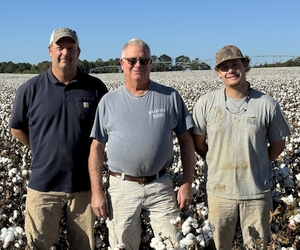Cotton Versus Synthetics
In a highly competitive market, it is imperative that you size up your competition. You know: stretch them out, see how they breathe, pull apart the threads. For cotton, that means taking an extra fine look at chemical and non-chemical synthetic fibers.
| Cotton’s Market Share (percent) | |||
| Year | Industrial Countries |
Developing Countries |
Asia/ Oceania |
| 1981 | 37.4 | 57.1 | 45.7 |
| 1991 | 42.9 | 55.3 | 42.2 |
| 2001 | 43.4 | 39.8 | 43.9 |
| 2010 | 45.0 | 26.8 | 45.7 |
| Source: International Cotton Advisory Committee | |||
By the Numbers
The good news for cotton is that the industry can be innovative. From the development of higher quality cotton varieties to technological advances in processing, cotton is continually working to retain its relevancy.
At the same time, numbers are numbers. And some of the numbers are eye-opening. According to Alejandro Plastina, economist for the International Cotton Advisory Committee (ICAC), world textile fiber consumption more than quadrupled between the early 1960s and the late 2000s. Cotton consumption doubled during that same period, which may sound good until you consider that consumption of other non-cotton fibers (including synthetics and wool) increased sevenfold. The end result: cotton’s market share dropped sharply from an average of 63.4 percent to 39.5 percent from the 1960s to the 2000s. In other words, cotton’s market share today is about half of what it was 50 years ago.
The ICAC Textile Model projects that this trend — non-cotton fiber outpacing cotton — will continue and cotton’s market share could decline to 30.5 percent by 2020, Plastino notes.
Interestingly, cotton has lost much of its market share due to the consumption practices of developing nations. Over the past thirty years, ICAC data shows, their end-use consumption of non-cotton fibers has increased twice as fast as their consumption of cotton. In those developing countries, cotton’s market share has dipped from 57.1 percent in 1981 to 26.8 percent in 2010. Meanwhile, cotton’s market share in industrial nations has actually risen during that same time period (thanks, in large part, to sustained promotional efforts) and its market share in Asia/Oceania has remained the same.
| World Textile Fiber Consumption | |||||
| Year | Kg per Capita | Total Consumption* | Cotton’s Market Share Percent |
||
| Cotton | Non-Cotton | Cotton | Non-Cotton | ||
| 1960 | 3.43 | 1.59 | 10.36 | 4.80 | 68.3 |
| 1970 | 3.28 | 2.61 | 12.11 | 9.64 | 55.7 |
| 1980 | 3.23 | 3.45 | 14.30 | 15.29 | 48.3 |
| 1990 | 3.54 | 3.67 | 18.60 | 19.28 | 49.1 |
| 2000 | 3.30 | 4.92 | 19.98 | 29.81 | 40.1 |
| 2010 | 3.29 | 6.15 | 22.45 | 42.00 | 34.8 |
| *In million tonns Source: International Cotton Advisory Committee | |||||
Advantages and Disadvantages
Of course, many factors affect textile consumption — price, marketing campaigns, fiber quality, fashion trends and more. Recently, however, technological advancements have ruled the day.
Non-cotton fibers, synonymous with strength and durability, redefined the apparel market, for example, by delivering clothing with enhanced performance and aesthetics. Building on those recognized characteristics, today’s innovations in synthetics are wide-ranging. In apparel, manufacturers are incorporating thermal regulatory properties, protective properties (such as flame-retardance) and water absorption properties (without the feeling of wetness). Nano technologies and bicomponent fibers are making synthetics more efficient and versatile. And biodegradable, eco-conscious and recycled synthetic products are being developed in response to consumer demand.
For cotton, it’s all about exploiting one major advantage — polls have always shown that consumers prefer the feel of cotton — and proving that cotton can offer the same desired properties as synthetics.
Cotton Incorporated, one of the industry’s leading promotional voices, notes that recent textile innovations such as Natural Stretch, Storm Cotton, TransDRY and Wicking Windows, are making it possible for cotton to compete with synthetics in the apparel market. Natural Stretch provides elasticity; Storm Cotton features water repellent technology; and TransDRY and Wicking Windows are moisture management, or moisture transfer, technologies for cotton.
By guiding consumers to cotton through promotional efforts, encouraging manufacturers and retailers to provide the type of cotton products that consumers demand at a proper price point, and increasing the quality of the raw material, the cotton industry can regain its footing and begin the task of reversing market share losses.









